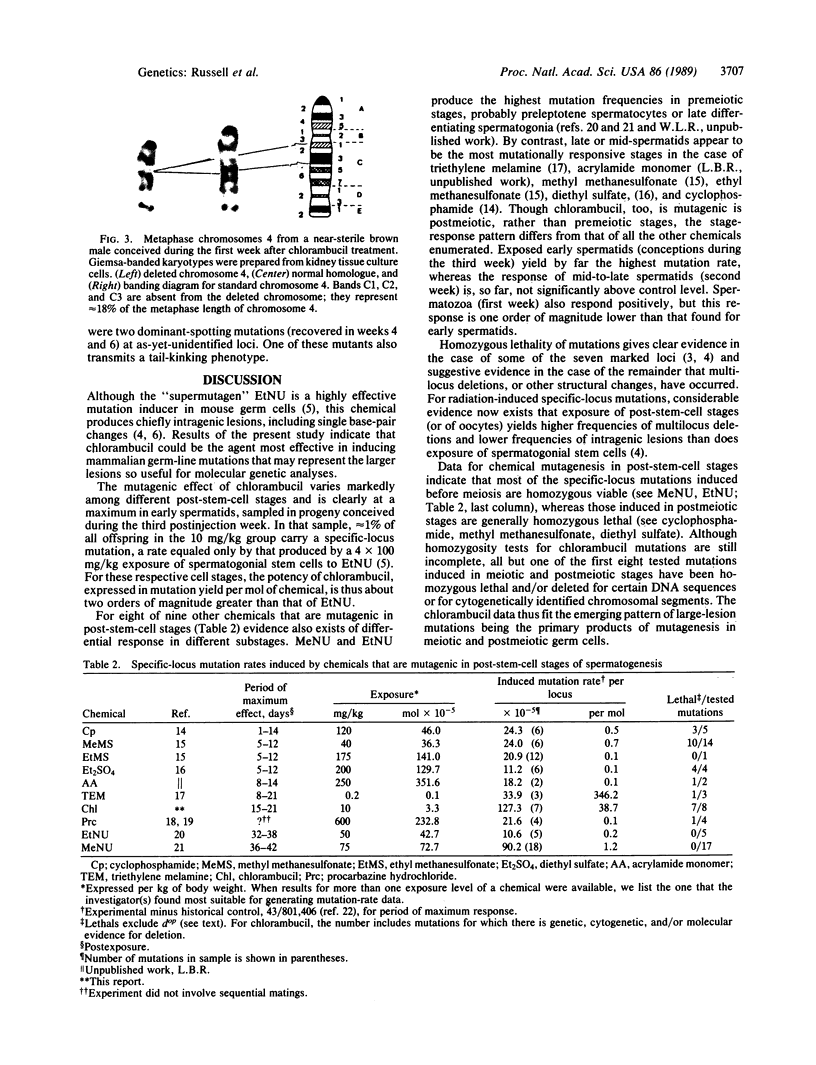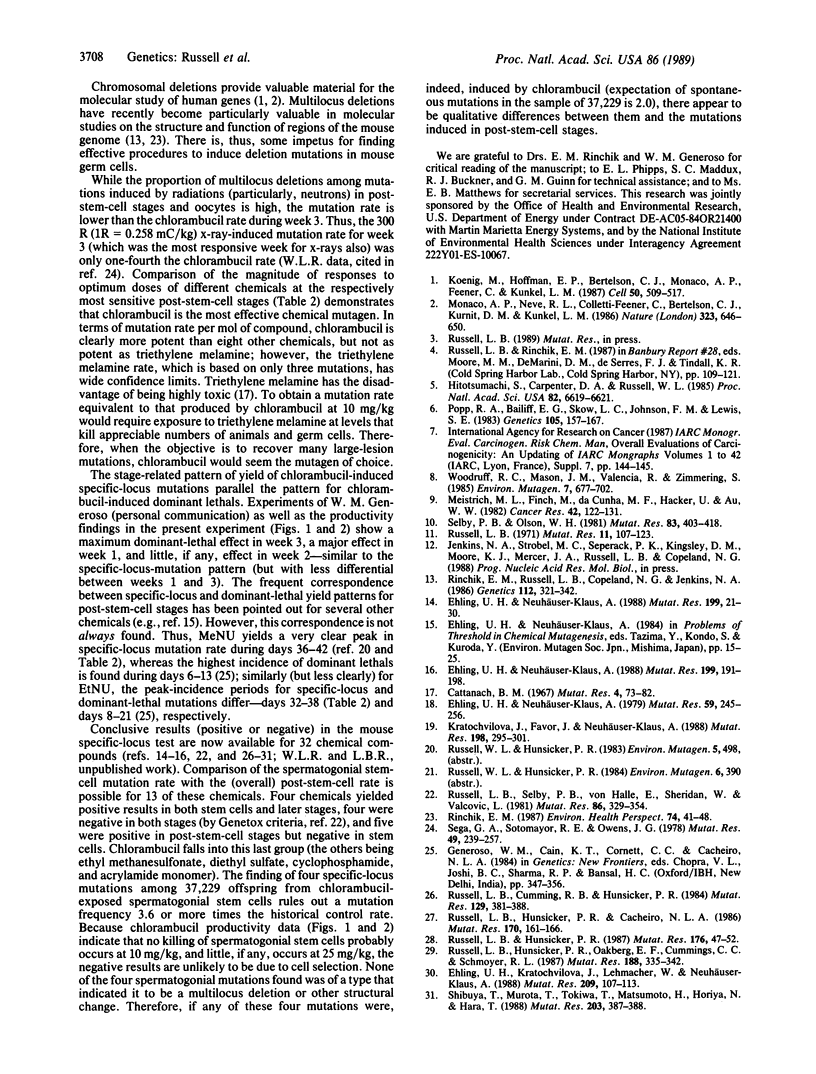Abstract
The chemotherapeutic agent chlorambucil was found to be more effective than x-rays or any chemical investigated to date in inducing high yields of mouse germ-line mutations that appear to be deletions or other structural changes. Induction of mutations involving seven specific loci was studied after exposures of various male germ-cell stages to chlorambucil at 10-25 mg/kg. A total of 60,750 offspring was scored. Mutation rates in spermatogonial stem cells were not significantly increased over control values; this negative result is not attributable to selective elimination of mutant cells. Mutations were, however, clearly induced in treated post-stem-cell stages, among which marked variations in mutational response were found. Maximum yield occurred after exposure of early spermatids, with approximately 1% of all offspring carrying a specific-locus mutation in the 10 mg/kg group. The stage-response pattern for chlorambucil differs from that of all other chemicals investigated to date in the specific-locus test. Thus far, all but one of the tested mutations induced by chlorambucil in post-stem-cell stages have been proved deletions or other structural changes by genetic, cytogenetic, and/or molecular criteria. Deletion mutations have recently been useful for molecular mapping and for structure-function correlations of genomic regions. For generating presumed large-lesion germ-line mutations at highest frequencies, chlorambucil may be the mutagen of choice.
Full text
PDF




Images in this article
Selected References
These references are in PubMed. This may not be the complete list of references from this article.
- Cattanach B. M. Induction of paternal sex-chromosome losses and deletions and of autosomal gene mutations by the treatment of mouse post-meiotic germ cells with triethylenemelamine. Mutat Res. 1967 Feb;4(1):73–82. doi: 10.1016/0027-5107(67)90111-x. [DOI] [PubMed] [Google Scholar]
- Ehling U. H., Kratochvilova J., Lehmacher W., Neuhäuser-Klaus A. Mutagenicity testing of vincristine sulfate in germ cells of male mice. Mutat Res. 1988 Nov-Dec;209(3-4):107–113. doi: 10.1016/0165-7992(88)90026-7. [DOI] [PubMed] [Google Scholar]
- Ehling U. H., Neuhäuser-Klaus A. Induction of specific-locus and dominant-lethal mutations by cyclophosphamide and combined cyclophosphamide-radiation treatment in male mice. Mutat Res. 1988 May;199(1):21–30. doi: 10.1016/0027-5107(88)90226-6. [DOI] [PubMed] [Google Scholar]
- Ehling U. H., Neuhäuser-Klaus A. Induction of specific-locus and dominant-lethal mutations in male mice by diethyl sulfate (DES). Mutat Res. 1988 May;199(1):191–198. doi: 10.1016/0027-5107(88)90245-x. [DOI] [PubMed] [Google Scholar]
- Ehling U. H., Neuhäuser A. Procarbazine-induced specific-locus mutations in male mice. Mutat Res. 1979 Feb;59(2):245–256. doi: 10.1016/0027-5107(79)90163-5. [DOI] [PubMed] [Google Scholar]
- Hitotsumachi S., Carpenter D. A., Russell W. L. Dose-repetition increases the mutagenic effectiveness of N-ethyl-N-nitrosourea in mouse spermatogonia. Proc Natl Acad Sci U S A. 1985 Oct;82(19):6619–6621. doi: 10.1073/pnas.82.19.6619. [DOI] [PMC free article] [PubMed] [Google Scholar]
- Koenig M., Hoffman E. P., Bertelson C. J., Monaco A. P., Feener C., Kunkel L. M. Complete cloning of the Duchenne muscular dystrophy (DMD) cDNA and preliminary genomic organization of the DMD gene in normal and affected individuals. Cell. 1987 Jul 31;50(3):509–517. doi: 10.1016/0092-8674(87)90504-6. [DOI] [PubMed] [Google Scholar]
- Kratochvilova J., Favor J., Neuhäuser-Klaus A. Dominant cataract and recessive specific-locus mutations detected in offspring of procarbazine-treated male mice. Mutat Res. 1988 Apr;198(2):295–301. doi: 10.1016/0027-5107(88)90006-1. [DOI] [PubMed] [Google Scholar]
- Meistrich M. L., Finch M., da Cunha M. F., Hacker U., Au W. W. Damaging effects of fourteen chemotherapeutic drugs on mouse testis cells. Cancer Res. 1982 Jan;42(1):122–131. [PubMed] [Google Scholar]
- Monaco A. P., Neve R. L., Colletti-Feener C., Bertelson C. J., Kurnit D. M., Kunkel L. M. Isolation of candidate cDNAs for portions of the Duchenne muscular dystrophy gene. Nature. 1986 Oct 16;323(6089):646–650. doi: 10.1038/323646a0. [DOI] [PubMed] [Google Scholar]
- Popp R. A., Bailiff E. G., Skow L. C., Johnson F. M., Lewis S. E. Analysis of a mouse alpha-globin gene mutation induced by ethylnitrosourea. Genetics. 1983 Sep;105(1):157–167. doi: 10.1093/genetics/105.1.157. [DOI] [PMC free article] [PubMed] [Google Scholar]
- Rinchik E. M. Molecular analysis of heritable mouse mutations. Environ Health Perspect. 1987 Oct;74:41–48. doi: 10.1289/ehp.877441. [DOI] [PMC free article] [PubMed] [Google Scholar]
- Rinchik E. M., Russell L. B., Copeland N. G., Jenkins N. A. Molecular genetic analysis of the dilute-short ear (d-se) region of the mouse. Genetics. 1986 Feb;112(2):321–342. doi: 10.1093/genetics/112.2.321. [DOI] [PMC free article] [PubMed] [Google Scholar]
- Russell L. B., Cumming R. B., Hunsicker P. R. Specific-locus mutation rates in the mouse following inhalation of ethylene oxide, and application of the results to estimation of human genetic risk. Mutat Res. 1984 Dec;129(3):381–388. doi: 10.1016/0027-5107(84)90093-9. [DOI] [PubMed] [Google Scholar]
- Russell L. B. Definition of functional units in a small chromosomal segment of the mouse and its use in interpreting the nature of radiation-induced mutations. Mutat Res. 1971 Jan;11(1):107–123. doi: 10.1016/0027-5107(71)90036-4. [DOI] [PubMed] [Google Scholar]
- Russell L. B., Hunsicker P. R., Cacheiro N. L. Mouse specific-locus test for the induction of heritable gene mutations by dibromochloropropane (DBCP). Mutat Res. 1986 Jun;170(3):161–166. doi: 10.1016/0165-1218(86)90030-3. [DOI] [PubMed] [Google Scholar]
- Russell L. B., Hunsicker P. R., Oakberg E. F., Cummings C. C., Schmoyer R. L. Tests for urethane induction of germ-cell mutations and germ-cell killing in the mouse. Mutat Res. 1987 Aug;188(4):335–342. doi: 10.1016/0165-1218(87)90010-3. [DOI] [PubMed] [Google Scholar]
- Russell L. B., Hunsicker P. R. Study of the base analog 6-mercaptopurine in the mouse specific-locus test. Mutat Res. 1987 Jan;176(1):47–52. doi: 10.1016/0027-5107(87)90251-x. [DOI] [PubMed] [Google Scholar]
- Russell L. B., Selby P. B., von Halle E., Sheridan W., Valcovic L. The mouse specific-locus test with agents other than radiations: interpretation of data and recommendations for future work. Mutat Res. 1981 May;86(3):329–354. doi: 10.1016/0165-1110(81)90010-5. [DOI] [PubMed] [Google Scholar]
- Sega G. A., Sotomayor R. E., Owens J. G. A study of unscheduled DNA synthesis induced by X-rays in the germ cells of male mice. Mutat Res. 1978 Feb;49(2):239–257. doi: 10.1016/0027-5107(78)90163-x. [DOI] [PubMed] [Google Scholar]
- Woodruff R. C., Mason J. M., Valencia R., Zimmering S. Chemical mutagenesis testing in Drosophila. V. Results of 53 coded compounds tested for the National Toxicology Program. Environ Mutagen. 1985;7(5):677–702. doi: 10.1002/em.2860070507. [DOI] [PubMed] [Google Scholar]



